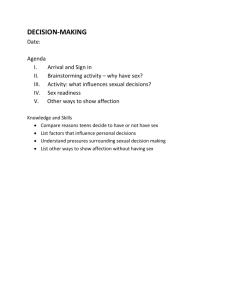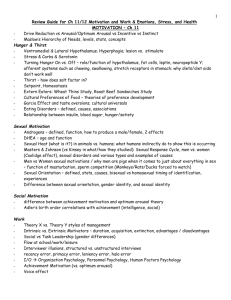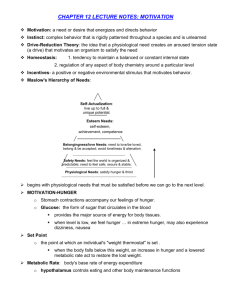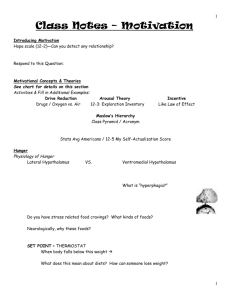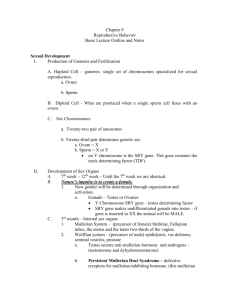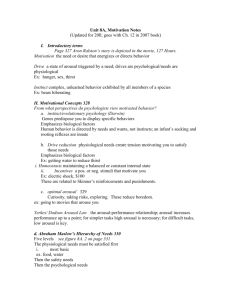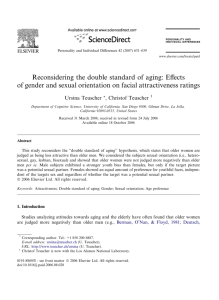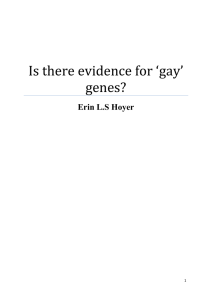Guided Notes – Motivation, Emotion, and Stress – #1
advertisement
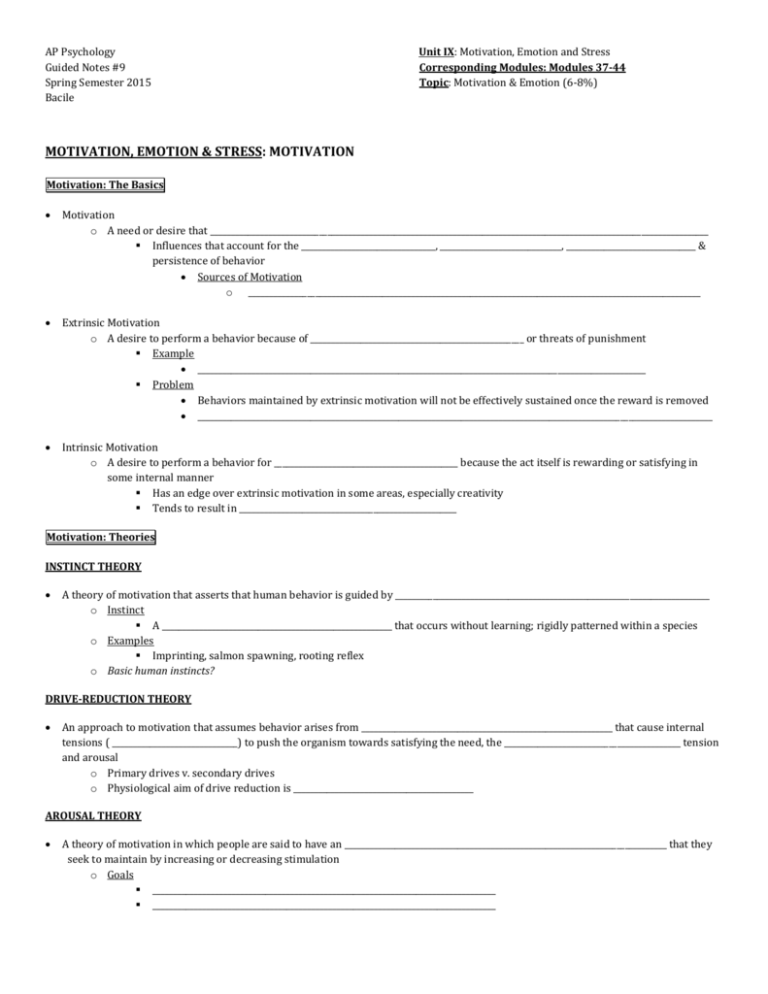
AP Psychology Guided Notes #9 Spring Semester 2015 Bacile Unit IX: Motivation, Emotion and Stress Corresponding Modules: Modules 37-44 Topic: Motivation & Emotion (6-8%) MOTIVATION, EMOTION & STRESS: MOTIVATION Motivation: The Basics Motivation o A need or desire that _______________________________________________________________________________________________________________________ Influences that account for the ________________________________, _____________________________, _______________________________ & persistence of behavior Sources of Motivation o ____________________________________________________________________________________________________________ Extrinsic Motivation o A desire to perform a behavior because of ___________________________________________________ or threats of punishment Example ___________________________________________________________________________________________________________ Problem Behaviors maintained by extrinsic motivation will not be effectively sustained once the reward is removed ___________________________________________________________________________________________________________________________ Intrinsic Motivation o A desire to perform a behavior for ____________________________________________ because the act itself is rewarding or satisfying in some internal manner Has an edge over extrinsic motivation in some areas, especially creativity Tends to result in ____________________________________________________ Motivation: Theories INSTINCT THEORY A theory of motivation that asserts that human behavior is guided by ___________________________________________________________________________ o Instinct A _______________________________________________________ that occurs without learning; rigidly patterned within a species o Examples Imprinting, salmon spawning, rooting reflex o Basic human instincts? DRIVE-REDUCTION THEORY An approach to motivation that assumes behavior arises from ____________________________________________________________ that cause internal tensions ( ______________________________) to push the organism towards satisfying the need, the __________________________________________ tension and arousal o Primary drives v. secondary drives o Physiological aim of drive reduction is ___________________________________________ AROUSAL THEORY A theory of motivation in which people are said to have an _____________________________________________________________________________ that they seek to maintain by increasing or decreasing stimulation o Goals __________________________________________________________________________________ __________________________________________________________________________________ YERKES-DODSON LAW The theory that psychological arousal helps performance, but __________________________________________________________________________ o The optimum level of arousal depends on the __________________________________________________________________________________ _____________________________________ has an optimum level of stimulation that they prefer to maintain INCENTIVE THEORY A theory of motivation in which incentives (either positive or negative stimuli) __________________________________________________________________ o Behavior is guided by the _________________________________________________________________________________ and the threat of punishment MASLOW’S HIERARCHY OF NEEDS Abraham Maslow (1908-1970) o Humanistic psychologist who developed the hierarchy of needs, stating that some needs take priority over others Begins at the base with physiological needs, and then proceeds through ________________________________________________ to psychological needs _________________________________________________ won’t become active until lower-level needs have been satisfied Motivation: Hunger THE BIOLOGICAL BASES OF HUNGER Hunger DOES NOT ___________________________________________________ It comes from our brain o Hypothalamus Regulates appetite; serves as __________________________________________________ Damage to this area can cause weight gain due to lack of restraint in eating Ventromedial Hypothalamus (VMH) o _____________________________________________________ (upon stimulation) o If the VMH is destroyed, ________________________________________________________ Lateral Hypothalamus (LH) o _____________________________________________________ (upon stimulation) o If the LH is destroyed, ___________________________________________________________ Hormone Orexin (increase) Ghrelin (increase) Insulin (increase) Leptin (increase) PYY (increase) Tissue/Location Response Weight Set Point o __________________________________________________________________________________________________________________________________________________ Basal Metabolic Rate (BMR) o __________________________________________________________________________________________________________________________________________________ When the body falls _____________________________________________________, increased hunger & a lower BMR may act to ____________________________ the weight lost weight…. Implications for Dieting o A “normal” weight person who overeats will experience an ______________________________________________________________________________, thus preventing weight gain o A “normal” weight person who under eats will experience a decrease in metabolism, thus ___________________________________________ ______________________________________________ The body reacts as if it is in starvation mode… Set Point Theory explains why so many “successful” dieters regain the weight; they return to set point o Set Point still valid? Settling point? THE PSYCHOLOGY OF HUNGER External Influences o Sight, sound and smell of food o Memory (of last meal…) Due to difficulties with _____________________________________, amnesia patients eat frequently if given food Cultural/Environmental Influences o Taste preferences Biology or culture? ________________________________________________________________________________________________________ Others? o Conditioned & in many cases adaptive Anorexia Nervosa o An eating disorder in which a person becomes ____________________________________________________________________ (15%) Self-starvation diets, extreme exercise regimens and delusions Bulimia Nervosa o An eating disorder characterized by episodes of __________________________________________ (high-caloric foods), followed by vomiting, laxative use, fasting or excessive exercise ___________________________________________________________________________________________________ Binge-Eating Disorder Statistics (WHO, 2007) o Overweight: ___________________________________________________ o Clinically Obese: ______________________________________________ (BMI 30+) Which is more dangerous? o Apple or pear shape? Why? Obesity o A disorder characterized by excessive weight ________________________________________________________ ________________________________________________________ o Obesity gene? Heritability of obesity? Motivation: Sex Obviously… o Sex is natural o Without sex, none of us would be here “Sex is nature’s clever way of making people procreate, enabling our species to survive…” o So… How do researchers study sex? THE BIOLOGICAL BASES OF SEX Alfred Kinsey (1950s) o Research/biologist at the University of Indiana Published Sexual Behavior in the Human Male (1948) and Sexual Behavior in the Human Female _________________________________________________________________________ with 18,000 people in the early 1950s Pioneer in terms of sex research o The ______________________________________________________ (1-6) Rating Description 1 2 Predominantly heterosexual, only incidentally homosexual 3 Predominantly heterosexual, but more than incidentally homosexual 4 5 Predominantly homosexual, but more than incidentally heterosexual 6 Predominantly homosexual, only incidentally heterosexual x William Masters & Virginia Johnson (1960s) Set out to explore the ___________________________________________________________________________ o 382 females and 312 males After their research was complete they ran an institute that claimed to “turn” _______________________________________________ o Described the sexual response cycle _______________________________________ _______________________________________ _______________________________________ _______________________________________ Hormones & Sexual Behavior o Sex hormones… ___________________________________________________________________________________________________________ Activate sexual behavior More loosely in humans than in animals… Impact of testosterone… In men? In women? Hormone fluctuations are normal… Sexual Problems/Dysfunction o Men generally suffer from two kinds of sexual problems _______________________________________________________ _______________________________________________________ o Women may suffer from orgasmic disorders External Influences o Erotic material Men? Women? Impact on sexual relationships? o Imagined Influences Dreams Fantasy Teen Pregnancy o Factors o Statistics Sexually Transmitted Diseases o Factors o Statistics Sexual orientation refers to a person’s preference for _____________________________________________________________________________________ relationships with individuals of the same sex, the other sex and/or either sex o Statistics o Origins of Sexual Orientation ________________________________________________________________________ The brain and sexual orientation Genes and sexual orientation Prenatal hormones and sexual orientation



